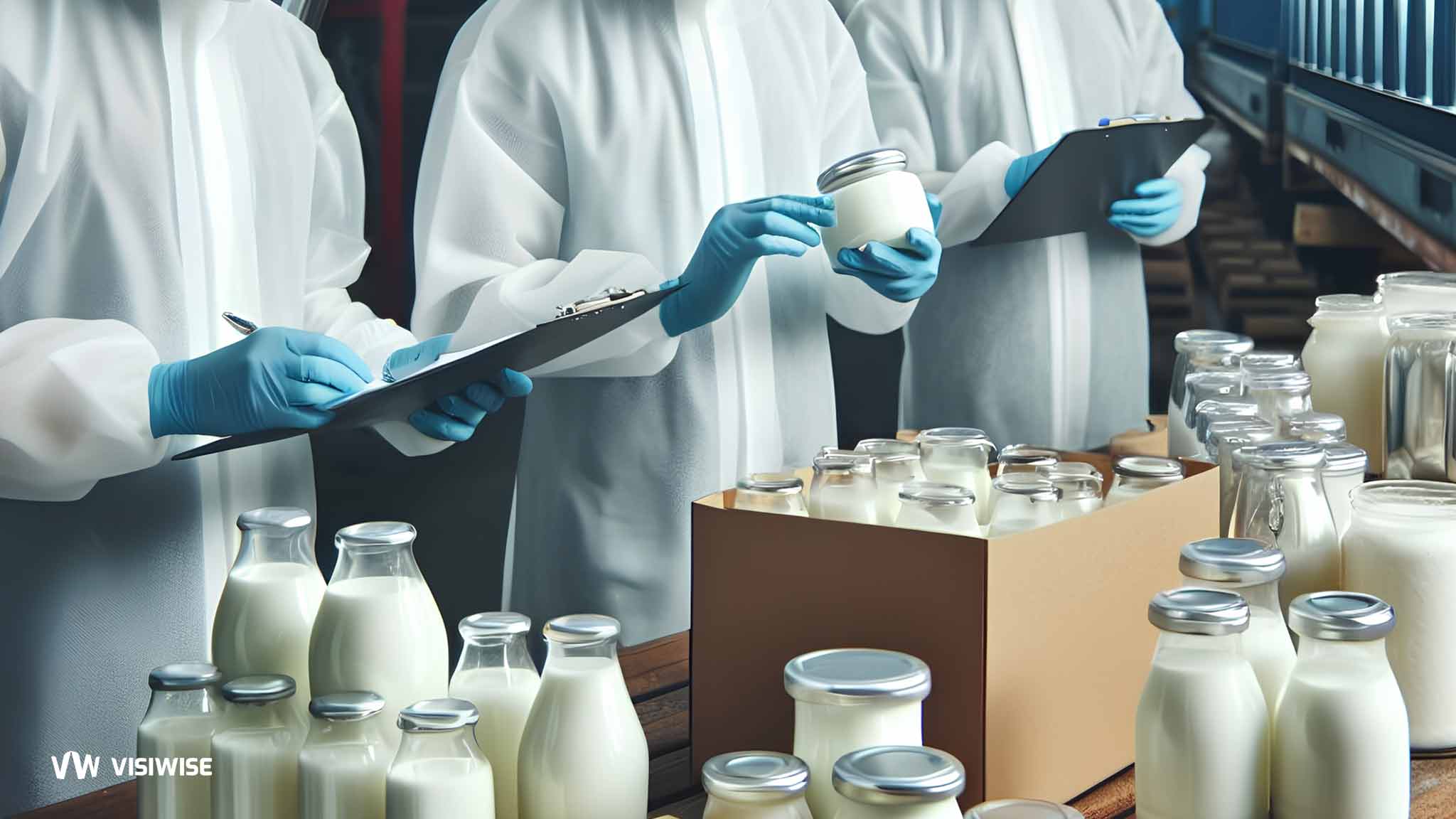Dairy shipping involves the transportation of perishable dairy products from one destination to another. Due to the perishable nature of dairy items, meticulous handling is required throughout the shipment process. Cold chain solutions play a crucial role in maintaining the freshness and quality of dairy products during transit. Various dairy shipping services are available, highlighting the importance of choosing the most suitable option. This comprehensive guide provides insights into dairy shipping, including its advantages, methods for shipping dairy products, and key considerations for selecting an appropriate shipping service.
Cold Chain Solutions for the Dairy Industry
Ensuring the freshness and safety of dairy products throughout their journey from farm to consumer requires top-tier cold chain solutions tailored to the complexities of the dairy industry.
Dairy staples like milk, cheese, and butter are integral to countless diets worldwide, constituting household essentials. With the dairy industry experiencing remarkable growth, nearly doubling in value every five years, meeting consumer demand hinges on implementing superior cold chain solutions. These solutions are indispensable for maintaining the cold temperatures necessary to preserve product quality and safety, thus ensuring consumer satisfaction and industry success.
The Importance of Cold Chain Solutions in the Dairy Industry
The dairy industry relies heavily on cold chain solutions due to the perishable nature of its primary ingredient: milk. With a short shelf life, milk must be swiftly transported from the milking process to cooling storage tanks or refrigerated trailers. Maintaining temperatures below 40 degrees Fahrenheit is imperative to prevent spoilage during storage and transportation. Once at a processing facility, milk undergoes pasteurization before being distributed to consumers.
Typically, this entire journey from cow to store shelf—occurs within a span of two days. However, milk serves as the foundation for a myriad of dairy products, each introducing additional steps and complexities to the supply chain. Hence, the implementation of robust cold chain solutions is essential to ensure product integrity and safety throughout the various stages of dairy production and distribution.
Common Issues Requiring Cold Chain Solutions
Temperature Control for Dairy Products
Maintaining precise temperature control is crucial for preserving the freshness and safety of dairy products throughout the supply chain. Dairy items require specific temperature ranges to prevent spoilage and bacterial growth, posing risks to consumer health if the cold chain is compromised. Without consistent refrigeration and humidity control, bacteria can proliferate, leading to potentially harmful contamination of dairy products.
Capacity Management During Peak Shipping Seasons
During peak shipping seasons, such as produce season, managing capacity becomes a critical concern for the dairy industry. While some dairy products may explore alternative transportation modes, shipping via truckload remains the primary choice due to its efficiency, speed, and cost-effectiveness, especially for heavy loads. Reefer trucks, equipped with refrigeration units, are essential for transporting dairy products, but their availability can be limited during peak seasons. This scarcity not only makes it challenging to secure transportation but also drives up costs, potentially impacting profitability. Moreover, utilizing refrigerated trucks minimizes the risks associated with temperature fluctuations and product shifting, ensuring the integrity of dairy shipments during transit.
Managing Milk Production with Dairy Demand
Balancing milk production with fluctuating consumer demand presents a unique challenge for the dairy industry. Unlike manufactured goods, milk production cannot be easily adjusted in response to market fluctuations. Cows continue to produce milk regardless of demand, necessitating careful management to avoid oversupply or shortages. Furthermore, the regional nature of milk shipping adds complexity to demand management, as transporting milk over long distances is costly and impractical due to its short shelf life.
Supply Chain Disruptions
The dairy industry is susceptible to supply chain disruptions, ranging from truck breakdowns to roadblocks, which can result in delays and potential product spoilage. With many dairy products, such as milk, having a limited shelf life, any disruption poses a significant risk of waste. To mitigate these risks, dairy companies must maintain agility and responsiveness to address disruptions promptly, ensuring minimal impact on product availability and quality.
Highly Regulated Nature of Dairy
Due to the risk of foodborne illnesses associated with dairy products, the industry is subject to stringent regulations. From milk production to transportation and processing, dairy products undergo rigorous testing and quality control measures to ensure consumer safety. Regulations such as the Food Safety Modernization Act (FSMA) impose strict requirements on sanitary transportation and handling practices, emphasizing the importance of maintaining high standards of hygiene and food safety throughout the dairy supply chain.
Supply Chain Visibility
Given the multitude of factors impacting dairy supply chains, maintaining full, real-time visibility is crucial for dairy companies. This visibility enables them to monitor various aspects of the supply chain, including production, transportation, and distribution, allowing for proactive management of potential issues such as disruptions, delays, and regulatory compliance requirements. Moreover, visibility aids in meeting the stringent requirements of wholesale food distributors and grocery warehouses, ensuring timely appointments and adherence to strict product quality inspections. Failure to maintain visibility puts dairy companies at risk of product losses, financial setbacks, and reputational damage.
Potential High-Value Products
Certain dairy products, such as specialty cheeses, possess high value, significantly impacting the overall value of the shipment. In the event of potential claims or damages, the financial stakes are elevated, underscoring the importance of working with experienced providers capable of handling high-value dairy products. Collaborating with expert providers mitigates risks associated with transportation, storage, and handling, safeguarding the value and integrity of premium dairy items throughout the supply chain.
Diary Shipping
Why Dairy Shipping is Important
Dairy shipping plays a pivotal role in the food industry by ensuring the delivery of fresh, uncontaminated dairy products to consumers. Maintaining the quality and safety of dairy items is paramount, considering their perishable nature. Furthermore, efficient dairy shipping contributes to environmental protection by safeguarding products against bacterial contamination. Given the perishability of dairy goods, maintaining their freshness throughout transport presents a challenge, underscoring the significance of proper shipping practices.
Benefits of Dairy Shipping
Dairy shipping is instrumental in transporting products from farms to grocery stores, ensuring the freshness of dairy items. Moreover, it stimulates job creation within the shipping sector and facilitates access to fresh dairy products, particularly for urban dwellers. As perishable goods, dairy products necessitate swift and efficient shipping to preserve their freshness, creating employment opportunities in the shipping industry. Specialized equipment and vehicles are imperative for the intricate process of shipping dairy products, with dedicated shipping companies offering tailored services to farms and retailers.
Challenges Facing Dairy Shipping
The dairy shipping industry confronts numerous challenges, ranging from meeting global demand to managing transportation costs amidst rising fuel prices. Additionally, evolving consumer preferences pose a challenge, as demands shift towards healthier dairy options. Despite these obstacles, the dairy shipping sector remains vital in sustaining the global food supply, necessitating collaborative efforts to address challenges and ensure the delivery of high-quality dairy products worldwide.
The Dairy Shipping Process
Modern dairy shipping processes have evolved significantly from historical methods, with contemporary practices emphasizing the use of refrigerated containers to preserve product freshness. Dairy products, including milk, cheese, and butter, constitute a substantial portion of global trade, underscoring the economic significance of dairy shipping. The dairy product supply chain encompasses various stages, from collection at farms to processing and distribution to consumers, each playing a critical role in maintaining product safety and quality.
Challenges in Dairy Shipping
Maintaining product freshness during transit and navigating customs regulations pose significant challenges in dairy shipping. Perishable nature necessitates strict temperature control, while customs regulations complicate international shipping processes. Despite these challenges, the growing demand for dairy products worldwide ensures a promising future for the shipping industry, albeit requiring continual adaptation to meet evolving consumer needs.
Cold Supply Chains in Dairy Shipping
Cold supply chains are integral to preserving the quality and freshness of dairy products throughout the shipping process. Specialized equipment, including refrigerated trucks and storage facilities, is indispensable for maintaining the desired temperature conditions. Time sensitivity further complicates the shipping process, necessitating prompt delivery to processing plants to uphold product quality standards. Overall, cold supply chains are crucial for ensuring that dairy products reach consumers in optimal condition, underscoring the complexity and importance of dairy shipping operations.
Effective Packaging Tips for Dairy Shipping
While many dairy products can be shipped without specialized packaging, attention to detail is crucial to ensure product integrity. Here are some essential tips to consider:
- Ensure Proper Sealing: Prioritize securing dairy products with robust sealing to prevent leakage or contamination during transit. Proper sealing safeguards against external factors and maintains product freshness.
- Protect from Temperature Fluctuations: Shield dairy products from temperature variations by employing suitable insulation methods. Utilize materials like dry ice or gel packs to maintain a consistent cool environment throughout the shipping process, preserving product quality.
- Optimal Cooling Methods: Choose cooling methods that effectively regulate temperatures to keep dairy products fresh. Whether using dry ice or gel packs, ensure they are strategically placed to evenly distribute cooling and prevent hot spots.
- Clear Labeling: Clearly label dairy products with instructions for storage and handling to inform recipients about proper care practices. Include information on temperature requirements and any special handling instructions to maintain product quality.
By adhering to these straightforward guidelines, you can enhance the chances of your dairy products arriving at their destination fresh and delectable, ensuring customer satisfaction.
Key Challenges in Dairy Product Delivery Packaging
Delivering dairy products safely from production to consumers’ hands presents several significant challenges for producers and distributors. Here are the primary hurdles they must overcome:
- Ensuring Hygiene Throughout the Supply Chain: Maintaining hygiene standards is paramount at every stage of the dairy product supply chain. From the farm to the final destination, risks of contamination abound, including spillages, dirt, mold, and contact with other food items. To mitigate these risks, appropriate dairy product delivery packaging is essential, providing a protective barrier against contaminants.
- Sustaining Constant Temperature Control during Storage and Transportation: Dairy products require consistent cold temperatures to preserve freshness and extend shelf life. This necessity influences the selection of warehousing facilities, transportation methods, and packaging materials. Fortunately, dairy product delivery packaging solutions offer temperature resistance suitable for cold storage environments, ensuring product integrity even during extended periods.
- Ensuring Gentle Handling: Dairy products are inherently fragile and susceptible to damage from mechanical shocks. Milk bottles, yogurt containers, and cheese blocks are prone to breakage if mishandled during transportation. Distributors face the challenge of balancing the need for careful handling with the demands of tight delivery schedules. To address this, they employ automated material handling equipment, necessitating dairy product delivery packaging with design features optimized for stability, grip, and compatibility with automated systems.
Recommended Dairy Products Delivery Packaging Solutions
In response to the challenges outlined, Logistic Packaging specialists propose the following returnable packaging solutions tailored for dairy deliveries:
- EURO Stack Nest Containers 180°:
These stackable and nestable plastic containers provide exceptional protection for delicate dairy products. Featuring a robust build and smooth inner walls to prevent marking, they ensure product integrity during transportation. Manufactured from food-grade raw materials, these containers are suitable for both bulk and packaged dairy items. Additionally, their space-saving design allows for up to 70% volume reduction when not in use, optimizing storage efficiency.
- Nestable Containers with Lids:
Designed for industries prioritizing hygiene, these containers with lids offer secure packaging for dairy products during transportation. Their sealable feature provides added protection, making them ideal for premium dairy items requiring utmost integrity. This packaging solution safeguards products from various interferences, ensuring freshness and quality upon arrival.
- Hygienic Pallets:
Completing the packaging unit, hygienic pallets provide a reliable base for stacking containers of dairy products. Specifically engineered for fast and thorough sanitization, these pallets are essential for maintaining hygiene standards throughout the supply chain. To enhance transportation safety, anti-slip mats and pallet covers can be added for additional product stability and protection. For extra protection during transportation, you can add anti-slip mats and pallet covers.
Different Methods of Dairy Shipping
Rail Transport: Rail transport, an age-old method, remains relevant in dairy shipping. Its efficiency over long distances and relatively low cost are notable advantages. However, its sluggish pace and susceptibility to weather disruptions pose challenges, potentially leading to delays.
Road Transport: Road transport stands as the predominant mode for dairy shipping due to its flexibility and affordability. Its adaptability for both short and long journeys is advantageous. Nonetheless, similar to rail transport, road shipping may encounter delays due to its slower pace and vulnerability to adverse weather conditions.
Ocean Transport: Ocean transport emerges as a favored choice for long-distance dairy shipping, offering efficiency and cost-effectiveness. Despite its advantages, its slower speed and susceptibility to weather-related disruptions may pose challenges and lead to delays.
Air Transport: Recognized as the swiftest mode of dairy shipping, air transport offers unparalleled speed and safety. However, its high cost and susceptibility to weather disturbances may deter its widespread use. Delays due to weather conditions remain a potential drawback.
each method of dairy transport presents its own set of advantages and disadvantages. The selection of the most suitable mode hinges on factors such as the distance of the journey, time constraints, and available budgetary resources.
Tips for Successful Dairy Shipping
- Maintain Cold Temperatures: Dairy products are highly perishable and require constant refrigeration to remain fresh. Ensure that products are kept at temperatures below 40 degrees Fahrenheit throughout the shipping process. Utilize refrigerated trucks and storage facilities to uphold optimal temperature conditions.
- Prioritize Timely Delivery: Swift transportation is essential for dairy products to maintain their quality. Products should be promptly delivered to processing plants following production to minimize the risk of spoilage and ensure freshness.
- Choose a Reliable Shipping Company: Select a shipping company with a proven track record in handling dairy products across international borders. Experience in dairy shipping ensures adherence to industry standards and efficient handling of perishable goods.
- Monitor Shipments: Stay informed about the whereabouts of your dairy shipments by utilizing tracking systems provided by shipping companies. Real-time tracking allows for proactive management and timely intervention in case of any deviations from the planned route or schedule.
Final Thoughts
While most dairy products can be shipped without specialized packaging, it’s crucial to adhere to key practices to maintain their freshness and quality. Ensuring products are well-sealed and shielded from temperature fluctuations is paramount, as is employing cooling methods like dry ice or gel packs to preserve optimal conditions during transit. Clear labeling further enhances the shipping process, providing recipients with essential storage and handling instructions. By following these simple yet vital tips, dairy producers and distributors can guarantee that their products arrive at their destination fresh, delicious, and ready to delight consumers.



